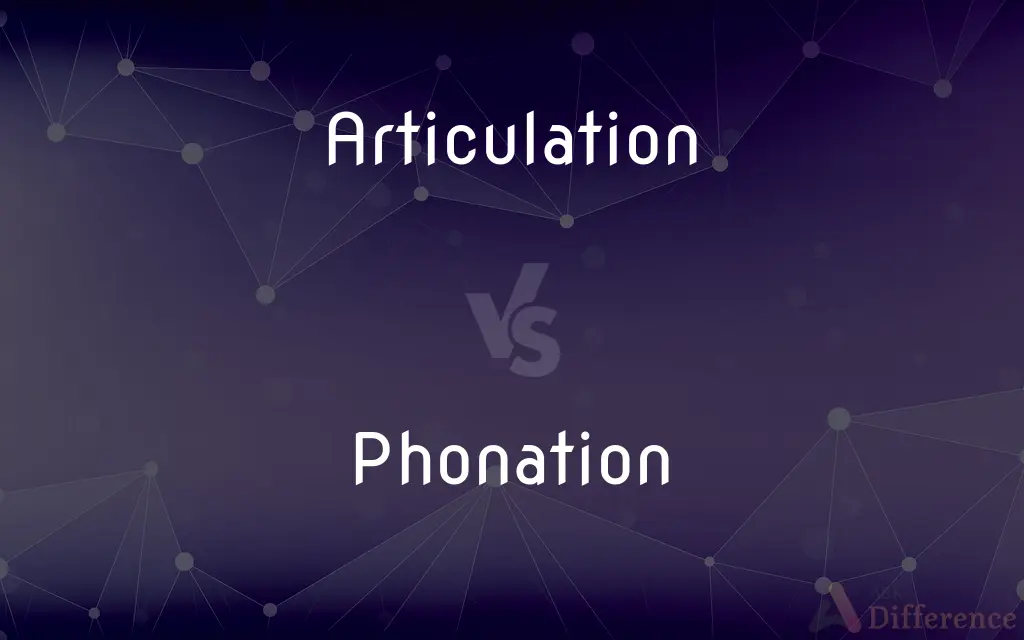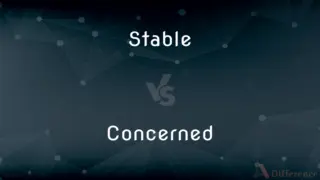Articulation vs. Phonation — What's the Difference?
By Fiza Rafique & Urooj Arif — Updated on April 23, 2024
Articulation involves the movement of the tongue, lips, and other speech organs to form distinct sounds, while phonation refers to the production of sound by the vocal cords within the larynx.

Difference Between Articulation and Phonation
Table of Contents
ADVERTISEMENT
Key Differences
Articulation is the physical mechanism where speech organs such as the tongue, lips, and teeth adjust to produce specific sounds, which are crucial for clear and precise speech. In contrast, phonation is primarily concerned with the vibration of the vocal folds to create sound, which serves as the raw vocal output before it is shaped into distinct sounds by articulators.
The process of articulation shapes the airflow and sound coming from the lungs into recognizable phonemes, which are the building blocks of language. On the other hand, phonation provides the vocal tone that articulation modifies, and it occurs in the larynx where the vocal cords reside.
Effective articulation is essential for the clarity of speech and can significantly affect the intelligibility of spoken language. Phonation, while it deals with sound production, does not by itself ensure that the produced sounds form meaningful language without the precise movements of the articulators.
Disorders related to articulation, such as dysarthria or articulatory phonological disorder, specifically affect the clarity and formation of speech sounds. Conversely, phonation issues might involve voice disorders like dysphonia or laryngitis, affecting the quality, pitch, and volume of the voice.
Training in articulation is often a key component of speech therapy aimed at improving speech clarity, particularly in languages with complex phonemic structures. Phonation, however, is targeted in both speech therapy and singing training to improve or repair vocal function and quality.
ADVERTISEMENT
Techniques to enhance articulation include exercises to strengthen tongue and lip movements, whereas techniques for improving phonation may involve breathing exercises and vocal cord strengthening practices.
Speech pathologists often assess both articulation and phonation when diagnosing and treating speech and language disorders, highlighting the interconnectedness of these processes in achieving effective verbal communication.
Comparison Chart
Definition
Movement of speech organs to form sounds
Production of sound by the vocal cords
Main Organs
Tongue, lips, teeth, palate
Vocal cords, larynx
Focus
Clarity and formation of distinct sounds
Production of raw sound
Related Disorders
Dysarthria, phonological disorders
Dysphonia, laryngitis
Therapy Focus
Enhancing clarity and precision of speech
Improving voice quality, pitch, and volume
Compare with Definitions
Articulation
Involves the adjustment of tongue, lips, and jaw.
Strong articulation skills are important for languages with many consonants.
Phonation
Can be disrupted by inflammation or misuse.
Overuse of the voice can lead to phonation issues.
Articulation
Critical for language clarity and intelligibility.
Speech therapists often work on articulation to help children articulate sounds clearly.
Phonation
The process of sound production in the vocal cords.
Phonation must be smooth for a clear voice.
Articulation
The formation of clear and precise speech sounds through organ movements.
Proper articulation is crucial for distinguishing between the sounds of 's' and 'sh'.
Phonation
Addressed through vocal training and therapy.
Vocal warm-ups improve phonation and prevent strain.
Articulation
Can be affected by neurological or developmental issues.
Articulation disorders may require extensive therapy.
Phonation
Occurs within the larynx where the vocal folds are located.
Singers often train to improve their phonation.
Articulation
Assessed through speech pathology.
Articulation tests determine if a child can make age-appropriate sounds.
Phonation
Fundamental to speech and singing.
Effective phonation is essential for both talking and vocal performances.
Articulation
The act of vocal expression; utterance or enunciation
An articulation of the group's sentiments.
Phonation
The term phonation has slightly different meanings depending on the subfield of phonetics. Among some phoneticians, phonation is the process by which the vocal folds produce certain sounds through quasi-periodic vibration.
Articulation
The act or manner of producing a speech sound.
Phonation
To produce speech sounds; vocalize.
Articulation
A speech sound, especially a consonant.
Phonation
(phonetics) The process of producing vocal sound by the vibration of the vocal folds that is in turn modified by the resonance of the vocal tract.
Articulation
A jointing together or being jointed together.
Phonation
The act or process by which articulate sounds are uttered; the utterance of articulate sounds; articulate speech.
Articulation
The method or manner of jointing.
Phonation
The sound made by the vibration of vocal folds modified by the resonance of the vocal tract;
A singer takes good care of his voice
The giraffe cannot make any vocalizations
Articulation
A fixed or movable joint between bones.
Articulation
A movable joint between inflexible parts of the body of an animal, as the divisions of an appendage in arthropods.
Articulation
A joint between two separable parts, as a leaf and a stem.
Articulation
A node or a space on a stem between two nodes.
Articulation
The conversion of a student's credits at one school to credits at another school by comparing the curricula.
Articulation
A joint or the collection of joints at which something is articulated, or hinged, for bending.
The articulation allowed the robot to move around corners.
Articulation
(countable) A manner or method by which elements of a system are connected.
Articulation
(uncountable) The quality, clarity or sharpness of speech.
His volume is reasonable, but his articulation could use work.
Articulation
(linguistics) The manner in which a phoneme is pronounced.
Articulation
The manner in which something is articulated (tongued, slurred or bowed).
The articulation in this piece is tricky because it alternates between legato and staccato.
Articulation
(accounting) The interrelation and congruence of the flow of data between financial statements of an entity, especially between the income statement and balance sheet.
Articulation
(education) The induction of a pupil into a new school or college.
Articulation
A joint or juncture between bones in the skeleton.
Articulation
The connection of the parts of a plant by joints, as in pods.
Articulation
The act of putting together with a joint or joints; any meeting of parts in a joint.
Articulation
The state of being jointed; connection of parts.
That definiteness and articulation of imagery.
Articulation
The utterance of the elementary sounds of a language by the appropriate movements of the organs, as in pronunciation; as, a distinct articulation.
Articulation
A sound made by the vocal organs; an articulate utterance or an elementary sound, esp. a consonant.
Articulation
The aspect of pronunciation that involves bringing articulatory organs together so as to shape the sounds of speech
Articulation
The shape or manner in which things come together and a connection is made
Articulation
Expressing in coherent verbal form;
The articulation of my feelings
I gave voice to my feelings
Articulation
(anatomy) the point of connection between two bones or elements of a skeleton (especially if the articulation allows motion)
Articulation
The act of joining things in such a way that motion is possible
Common Curiosities
What are common disorders associated with phonation?
Common phonation disorders include dysphonia and laryngitis, which affect voice quality and production.
Why is articulation important for effective communication?
Clear articulation is essential for effective communication as it ensures that speech sounds are distinct and understandable.
What role does the larynx play in phonation?
The larynx, containing the vocal cords, is crucial for phonation as it generates vocal sound.
How are articulation disorders treated?
Articulation disorders are treated through targeted speech therapy focusing on improving the movements of speech organs.
How do speech pathologists assess phonation?
Speech pathologists use various tools and tests to assess the quality and consistency of phonation.
What impacts can phonation disorders have on daily life?
Phonation disorders can impact social interactions and professional activities that rely on clear vocal communication.
How does phonation differ from articulation?
Phonation involves the production of sound at the vocal cords, while articulation shapes these sounds into speech.
What techniques improve articulation?
Techniques include practicing tongue twisters, strengthening exercises for the tongue and lips, and slowing down speech.
What is articulation in speech?
Articulation in speech refers to the way speech sounds are formed by movements of the mouth and other speech organs.
Can articulation issues affect language development?
Yes, poor articulation can significantly impact language development and clarity of speech.
What exercises help with phonation?
Exercises like vocal warm-ups and controlled breathing help improve phonation.
Is it possible to have both phonation and articulation problems?
Yes, individuals can experience both phonation and articulation problems, often requiring comprehensive speech therapy.
What are the benefits of addressing articulation early in children?
Early intervention for articulation can prevent future speech problems and boost confidence in verbal communication.
How does articulation affect learning languages?
Good articulation skills are vital for learning new languages accurately, especially those with different phonetic structures.
Can singing help improve phonation?
Singing can greatly improve phonation by strengthening the vocal cords and improving breath control.
Share Your Discovery

Previous Comparison
Stable vs. Concerned
Next Comparison
Shade vs. ShadowAuthor Spotlight
Written by
Fiza RafiqueFiza Rafique is a skilled content writer at AskDifference.com, where she meticulously refines and enhances written pieces. Drawing from her vast editorial expertise, Fiza ensures clarity, accuracy, and precision in every article. Passionate about language, she continually seeks to elevate the quality of content for readers worldwide.
Co-written by
Urooj ArifUrooj is a skilled content writer at Ask Difference, known for her exceptional ability to simplify complex topics into engaging and informative content. With a passion for research and a flair for clear, concise writing, she consistently delivers articles that resonate with our diverse audience.















































